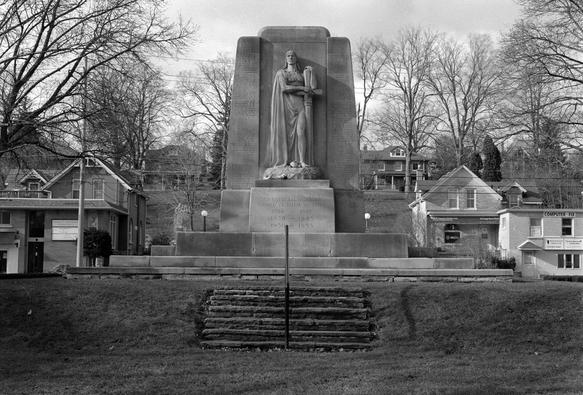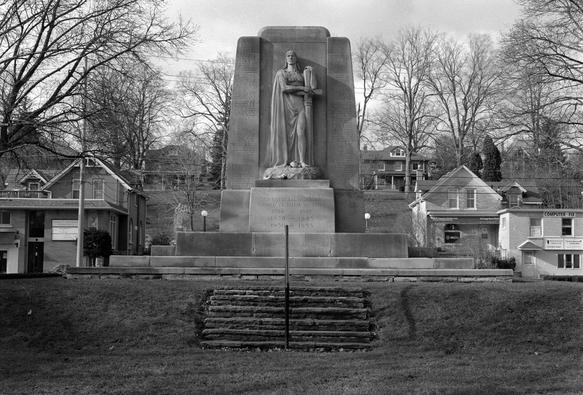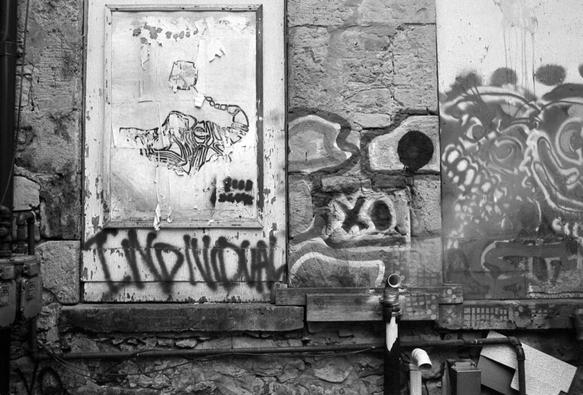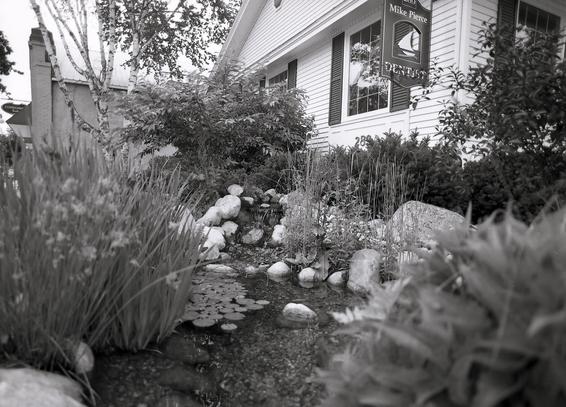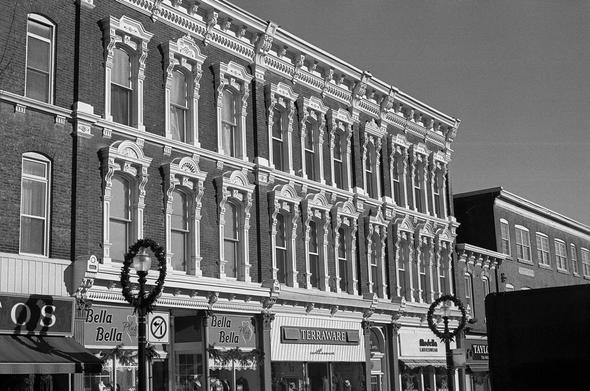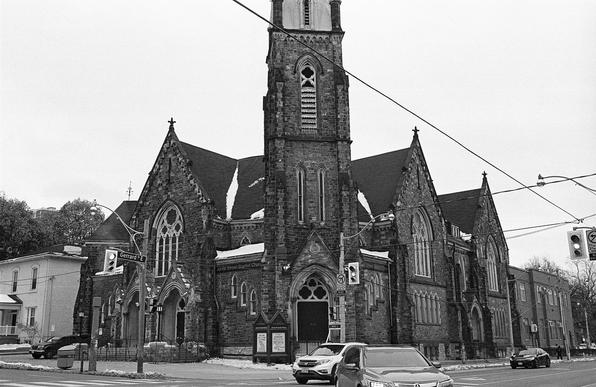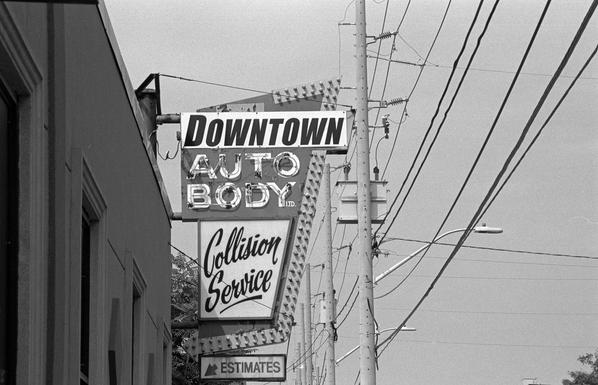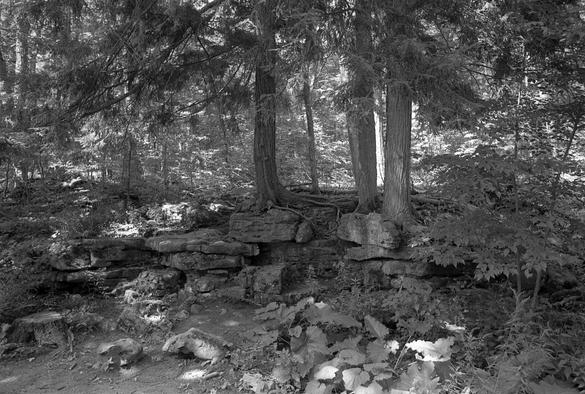Better Living Through Chemistry | Picking Your Developers
Developing your film at home is both rewarding and frustrating at the same time and to add on an extra layer of complexity there is a lot of developers out there that you can use, especially in the black & white field. While certainly not as much as there used to be, there is still an excellent selection of developers to suit almost every person's need, without having to dive deep into building your developers from base chemicals. Ultimately every photographer has a different taste but if you're starting out with home development the choices may seem a little overwhelming so I'll be breaking down the different characteristics you may look for in your developing and what I feel are the best choices for each characteristic.
General Purpose Developing
While there is always a temptation to dive right into the exotic, I have found it best to get your feet wet with a bit of boring, the idea behind a good general purpose developer is that it doesn't do anything beyond developing your film and letting you explore what your films can do first before altering it through changes in exposure and development. These developers often come in large volumes and allow for development using a stock dilution to help maximise the number of rolls you can develop in a kit. The first one in this mix is the old favourite, Kodak D-76. D-76 along with the various clones available including Flic Film Classic MQ, Ilford ID-11, FPP's Dalzell76, and many others comes in either a 1 gallon or 1 liter volume and offers up use as a reusable stock solution or you can dilute it down to 1+1 or 1+2 into a one-shot developer. In all cases, this developer will handle a good 90-95% of your development needs and can even offer up some use for push and pull development. And there is almost a development time for every B&W film available today and even in the past.
Mamiya m645 - Mamiya-Sekor C 1:2.8 f=80mm - Kodak Tri-X 400 @ ASA-200 - Ilford ID-11 (Stock) 6:00 @ 20CRolleiflex 2.8F - Carl Zeiss Planar 80mm 1:2.8 - Kodak TMax 100 @ ASA-100 - Kodak D-76 (1+1) 9:30 @ 20CNikon FE - AI-S Nikkor 35mm 1:2.8 - Kodak Tri-X 400 @ ASA-400 - Flic Film Classic MQ (1+1) 9:30 @ 20CRolleiflex 2.8F - Carl Zeiss Planar 80mm 1:2.8 - Rollei RPX 400 @ ASA-400 - Kodak D-76 (Stock) 8:00 @ 20CKyocera Contax G2 - Carl Zeiss Biogon 28/2,8 T* - Rollei RPX 25 @ ASA-25 - Kodak D-76 (1+1) 8:00 @ 20C
Second on my list for a good general purpose developer is Ilford Ilfosol 3, despite the drawbacks this is an excellent choice when starting with home developing. The developer comes in a liquid concentrate that is easy to work with and takes little effort to pour and mix. You only have two dilution options 1+9 and 1+14 that will both produce similar results it all depends on how many rolls of film you have to develop. Ilfosol 3 can only be used as a one-shot developer and it oxidises far quicker than other liquid developers. That means that you will want to shoot all your film and then run through to bottle as quickly as possible. Alternatively you can use canned air to help displace any oxygen or use glass marbles to keep the volume up. You also have a tonne of options for developing film with most modern film stocks having a listed time.
Nikon FG - Nikon Series E 50mm 1:1.8 - Ilford Pan F+ @ ASA-50 - Ilford Ilfosol 3 (1+14) 4:30 @ 20CHasselblad 500c - Carl Zeiss Planar 80mm 1:2.8 - Rollei RPX 100 @ ASA-100 - Ilford Ilfosol 3 (1+9) 5:00 @ 20CPentax 645 - SMC Pentax A 645 35mm 1:3.5 - Ilford Delta 100 @ ASA-100 - Ilford Ilfosol 3 (1+14) 2:50 @ 28CKyocera Contax G2 - Carl Zeiss Planar 2/45 T* - Ilford FP4+ @ ASA-125 - Ilford Ilfosol 3 (1+14) 7:30 @ 20CNikon F5 - AF-S Nikkor 14-24mm 1:2.8G - JCH Streetpan 400 @ ASA-400 - Ilford Ilfosol 3 (1+3) 5:00 @ 20C
And the third choice I have for general purpose developing is Adox FX-39 II, I first discovered this developer several years ago and it quickly became a fast favourite. This is another liquid concentrate that has only two dilutions available and is easily mixed into a one-shot working solution and in both cases they produce similar results so it all depends on how economical you want to be with your bottle. It also has a longer shelf life than Ilfosol 3, I've had one bottle go for a year and still was running strong by the time I drained the concentrate. The one thing that FX-39 II has that the previous two do not is a set of universal times for films exposed at box speed if there isn't a listed time. But don't worry, there is a lot of listed times available for the developer.
Rolleiflex 2.8F - Carl Zeiss Planar 80mm 1:2.8 - Adox CHS 100 II @ ASA-80 - Adox FX-39 II (1+9) 7:30 @ 20CMinolta Dynax 600si Classic - Minolta Maxxum AF 28mm 1:2.8 - Agfa Silvertone @ ASA-400 - Adox FX-39II (1+9) 10:00 @ 20C (Constant Rotation)Nikon F5 - AF Nikkor 85mm 1:1.8D - Ilford Delta 100 @ ASA-100 - Adox FX-39 II (1+9) 7:00 @ 20CNikon F5 - AF Nikkor 24mm 1:2.8 - Ilford Delta 400 @ ASA-400 - Adox FX-39 II (1+9) 9:30 @ 20CMinolta Maxxum 9 - Minolta Maxxum AF 28-135mm 1:4-4.5 - Kosmo Foto Agent Shadow @ ASA-400 - Adox FX-39 II (1+9) 10:30 @ 20C
Sharpness
Sharpness is both overrated and highly valued in the photography field, it's a bit of a buzz word. That being said there are several excellent options out there to help improve your film's sharpness. While sharpness can holistically mean a combination of edge sharpness and tonal contrast, these developers are used strictly to increase the edge sharpness of your images. The downside is that it will also increase the visible grain. The number one choice from anyone in this field is Rodinal, these days you can get it under several different names, Adox carries the copyright for the Rodinal name but in Canada we have the best clone, Blazinal. Rodinal can be used one of two ways, the first as a standard developer using either a 1+25 and 1+50 dilution for one-shot or you can stand-develop the film in a 1+100 or 1+200 dilution for either 1 hour or 2 hours respectively. While many people would avoid using Rodinal with faster films, I find that it does work well with both slow films that are already sharp, mid-speed films in the same vein and even faster films.
Hasselblad 500c - Carl Zeiss Planar 80mm 1:2.8 - Kodak Tri-X 400 @ ASA-200 - Blazinal (1+25) 7:00 @ 20CNikon F90 - AF Nikkor 35mm 1:2D - Bergger Pancro 400 @ ASA-800 - Blazinal (1+25) 13:00 @ 20CHasselblad 500c - Carl Zeiss Distagon 50mm 1:4 - Rollei RPX 25 @ ASA-25 - Blazinal (1+50) 11:00 @ 20CNikon F5 - AF-S Nikkor 28-70mm 1:2.8D - CatLABS X Film 320 Pro @ ASA-320 - Adox Rodinal (1+25) 9:00 @ 20CMamiya m645 - Mamiya-Sekor C 45mm 1:2.8 N - Ilford Ortho Plus @ ASA-80 - Blazinal (1+50) 15:00 @ 20C
Next on my list for increasing the edge sharpness of your film is Ilford Perceptol. While not necessarily a sharp developer, it does an excellent job in increasing sharpness while keeping visible grain under control. Perceptol is mixed from powder into a stock solution which you can use as a reusable developer (4 rolls per liter) or as a one-shot diluted either 1+1 or 1+3. It isn't the most economical developer either way as it is only available in a 1 liter kit. This is also the developer that does wonders with almost every film that you develop with it, the one thing you will notice in some cases is that you will have a bit of speed loss with faster films.
Pentax K1000 - SMC Pentax 55mm 1:2 - Ilford HP5+ @ ASA-320 - Ilford Perceptol (1+1) 18:00 @ 20CRolleiflex 2.8F - Carl Zeiss Planar 80mm 1:2.8 - Kodak Tri-X 400 (400TX) @ ASA-320 - Ilford Perceptol (1+1) 12:00 @ 20CMinolta Maxxum 9 - Minolta Maxxum AF 50mm 1:1.4 - Fujifilm Neopan Acros 100 @ ASA-80 - Ilford Perceptol (1+1) 13:00 @ 20C (Constant Rotation)Pentax 645 - SMC Pentax A 645 35mm 1:3.5 - Ilford Delta 100 @ ASA-50 - Ilford Perceptol (1+1) 13:00 @ 20CHasselblad 500c - Carl Zeiss Planar 80mm 1:2.8 - Rollei RPX 25 @ ASA-25 - Ilford Perceptol (1+1) 10:00 @ 20C
On the rarer end of the spectrum there's SPUR HRX. SPUR is known for producing developers designed for increased sharpness and resolution and HRX certainly fits the bill. I mean there name is short for Speed Photography, Ultra Resolution and HRX is for High-Resolution X. Now the one thing that might turn people off of HRX other than sourcing the chemisty is that it's a two-part developer with a single dilution. So there's a bit of math involved by dividing the amount of concentrate in two. And HRX will hand down some amazingly sharp images but on faster films there is a speed loss and an uptick in visible grain.
New Mamiya 6 - Mamiya G 1:3.5 f=75mm L - Kodak Tri-X 400 @ ASA-250 - SPUR HRX (1+17) 10:00 @ 20C (Constant Rotation)Canon EOS Elan IIe - Canon Lens EF 50mm 1:1.8 - Oriental Seagull 400 @ ASA-400 - SPUR HRX (1+13) 12:30 (Constant Rotation)Rolleiflex 2.8F - Carl Zeiss Planar 80mm 1:2.8 (Yellow-12) - Fomapan 100 @ ASA-100 - SPUR HRX (1+20) 11:00 @ 20CRolleiflex 2.8F - Carl Zeiss Planar 80mm 1:2.8 - FPP Frankenstein 200 @ ASA-125 - SPUR HRX (1+17) 7:45 @ 20C (Constant Rotation)Zeiss Ikon Contax IIIa - Zeiss Opton Sonnar 1:1,5 f=50mm - Ilford FP4+ @ ASA-100 - SPUR HRX (1+20) 9:30 @ 20C
Fine-Grain
On the opposite end of the spectrum there's fine-grain developers. These are ones that are designed to reduce the amount of visible grain. Now in the past this has often resulted in a loss of edge sharpness but most modern developers are a balance of retaining sharpness while reducing the amount of visible grain. Number one on my list is Ilford Microphen. Microphen, a cousin to Perceptol does an excellent job with reducing grain while maintaining decent edge sharpness and controlling contrast. It can be used as both a stock reusable solution (up to 10 rolls) or as a one-shot developer in either a 1+1 or 1+3 dilution. This works incredible well in the stock dilution in cutting down grain on some of the worst offenders like Fomapan 400, Fomapan 200, and ORWO N74.
Rolleiflex 2.8F - Carl Zeiss Planar 80mm 1:2.8 - Rollei Retro 80s @ ASA-80 - Ilford Microphen (Stock) 9:00 @ 20CNikon FM - AI-S Nikkor 105mm 1:2.5 - Fomapan 100 @ ASA-100 - Ilford Microphen (1+1) 9:00 @ 20CMinolta Maxxum 9 - Minolta Maxxum AF 28mm 1:2.8 (Yellow-12) - Ilford Ortho Plus @ ASA-80 - Ilford Microphen (Stock) 9:00 @ 20CMamiya m645 - Mamiya-Sekor C 1:2.8 f=80mm - Lomography Berlin 400 @ ASA-400 - Ilford Microphen (Stock) 7:00 @ 20CNikon FM - AI-S Nikkor 35mm 1:2.8 - Fomapan 100 @ ASA-100 - Ilford Microphen (1+1) 9:00 @ 20C
Second is the obvious choice, Kodak Xtol. This is the second fine-grain developer released by Kodak and was the final developer to come out of Kodak. You can also find it in several clones including Adox XT-3 and Bellini Foto Eco Developer plus several others. If you do a high-volume of developing then Xtol and XT-3 come in 5 liter volumes. The one thing that stands out for Xtol is that not only does it cut down on the visible grain, it also helps retains some level of edge sharpness. Now recently there were some concerns over the quality of the Xtol developer coming out of Sino Promise, but now that manufacturing has switched back to a US based company there doesn't seem to be the same problem. In all cases you can use the developer in stock form as a reusable developer or dilute it to one-shot in either 1+1 or 1+2 dilutions with only slight changes to how the developer acts.
Nikon FM - AI Nikkor 28mm 1:3.5 - Fomapan 200 @ ASA-200 - Adox XT-3 (Stock) 6:00 @ 20CNikon F5 - AF-S Nikkor 14-24mm 1:2.8G - FPP Mr. Brown @ ASA-6 - Kodak Xtol (stock) 10:30 @ 20CPentax 645 - SMC Pentax A 645 75mm 1:2.8 - Kodak Tri-X Pan (TXP) @ ASA-1250 - Kodak Xtol (Stock) 12:00 @ 20CHasselblad - 500c - Carl Zeiss Distagon 50mm 1:4 - Fuji Acros 100 @ ASA-100 - Kodak Xtol (stock) 8:00 @ 20CRolleiflex 2.8F - Carl Zeiss Planar 80mm 1:2.8 - Ilford HP5+ @ ASA-1600 - Bellini EcoFilm (Stock) 11:00 @ 20C (Constant Rotation)
The final choice is an interesting one as it is the developer that Xtol replaced, Kodak Microdol-X. Today you cannot find Microdol-X new, but if you come across a sealed pouch of the stuff then it should still be good! Rather LegacyPro makes a perfect clone of Microdol-X called Mic-X. This can be used three different ways, first is in the stock form where it is a perfect fine-grain developer and reusable but at the cost of reducing some of that edge sharpness. Second in a 1+3 one-shot dilution it does increase edge sharpness and in the third form a 1+1 one-shot dilution it is a balance of both. But even in the stock form with a modern sharp film, you don't see much reduction.
Pacemaker Crown Graphic - Schneider-Krueznack Symmar-S 1:5.6/210 - Kodak Plus-X Pan @ ASA-125 - Kodak Microdol-X (Stock) 8:00 @ 20CMamiya m645 - Mamiya-Sekor C 1:2.8 f=80mm - Fomapan 100 @ ASA-100 - LegacyPro Mic-X (1+1) 9:00 @ 20C (Constant Rotation)Minolta Dynax 600si Classic - Minolta Maxxum AF 24mm 1:2.8 (Yellow-12) - Ilford FP4+ @ ASA-25 - LegacyPro Mic-X (1+3) 10:00 @ 20C (Constant Rotation)Canon EOS 3000 - Canon Lens EF 50mm 1:1.8 - Arista EDU.Ultra 200 @ ASA-200 - LegacyPro Mic-X (1+1) 8:30 @ 20CRolleiflex 2.8F - Carl Zeiss Planar 80mm 1:2.8 (Yellow 8) - Kodak TMax 400 @ ASA-400 - LegacyPro Mic-X (Stock) 9:15 @ 20C (Constant Rotation)
Compensating Developers
A compensating developer is such a loaded term which is why I'm putting it in the final spot for this entry. The main reason is that I have already talked about a tonne of different developers that can be considered compensating. Ones like Xtol and Microphen all are in this category. These are developers that will help cut down some of the negative impacts of both push and pull development which compensate for over and under exposure. They also work well with expired films and help reduce grain and cut down on overly contrasty scenes or films. At the top of my list for compensating developers in Diafine. Now Diafine can be hard to acquire today, but there are similar developers being produced, I do believe that Bellini Foto has one and Flic Film has teased at something similar. Diafine is a two-bath developer, meaning you develop the film once in Part A then develop the film a second time in Part B. There is also a standard set of times that if you expose the film at an ideal speed you can develop multiple rolls at multiple speeds at the same time. And the best part is that I've seen good results no matter what film I've used with Diafine. And if you do get your hands on the stuff it tends to last forever.
Minolta Maxxum 9 - Minolta Maxxum AF 24mm 1:2.8 - Eastman Double-X 5222 @ ASA-1600 - Diafine (Stock) 4:00 + 4:00 @ 20CNikon F5 - AF Nikkor 50mm 1:1.4D - FPP XRay Film @ ASA-400 - Diafine (Stock) 5:00 + 5:00 @ 20CKonica-Minolta Maxxum 70 - Minolta Maxxum AF 50mm 1:1.7- Arista EDU.Ultra 100 @ ASA-200 - Diafine (Stock) 3:00 + 3:00 @ 20CNikon FE2 - AI Nikkor 24mm 1:2.8 (Yellow-12) - Ilford FP4+ @ ASA-250 - Diafine (Stock) 3:00 + 3:00 @ 20CMinolta Dynax 600si Classic - Minolta Maxxum AF 50mm 1:1.4 - Ilford HP5+ @ ASA-800 - Diafine (Stock) 3:00 + 3:00 @ 20C
Second on my list might raise some eyebrows but it's Kodak HC-110 along with the various clones including Ilfotec HC and LegacyPro L110. The one thing I like about HC-110 is that you can adjust how the developer can adjust to either help increase contrast or decrease contrast and even get into compensating territory. Now if you're running the stronger dilutions like A (1+15) and B (1+31) it acts more like a general purpose developer. But once you get into more dilute mixes like E (1+47), F (1+79), G (1+119) H (1+63), and even a special 1+90 with a fixed 18 minute time that will develop most B&W films when exposed at box speed. Now many people will turn there nose up at HC-110 these days because of the change of how the developer handles, it works well in Ilfotec HC that behaves similar to the original HC-110.
Minolta XE-7 - Minolta MD W.Rokkor-X 28mm 1:2.8 - Svema FN64 @ ASA-64 - Kodak HC-110 Dil. H 16:00 @ 20CMinolta Maxxum 9 - Konica-Minolta Zoom AF 17-35mm 1:2.8-4 D - Lomography Potsdam 100 @ ASA-100 - Kodak HC-110 Dil. H 7:30 @ 20C>Rolleiflex 2.8F - Carl Zeiss Planar 80mm 1:2.8 - JCH Streetpan 400 @ ASA-400 - Kodak HC-110 Dil. F 12:30 @ 20CKyocera Contax G2 - Carl Zeiss Biogon 2.8/28 T* - Kodak Tri-X 400 @ ASA-400 - Kodak HC-110 Dil. B 4:30 @ 20CKyocera Contax G2 - Carl Zeiss Biogon 2,8/28 T* - Eastman 5363 @ ASA-25 - Kodak HC-110 Dil. G 22:00 @ 20C
And finally there is Zone Imaging 510-Pyro, this is one of my favourite developers to use when I want a good balance between edge-sharpness and fine-grain. Now Pyro developers are not for everyone as there is a lot of extras needed to get the best out of the developer and your negatives. But between all the available pyro developers, 510-Pyro is the easiest to handle. It has only one concentrate and is mixed 90% of the time at a 1+100 dilution. It is thicker than other pyro developers but does have an incredibly long shelf-life. Honestly, I have yet to find a film stock that 510-Pyro doesn't like.
Rolleiflex 2.8F - Carl Zeiss Planar 80mm 1:2.8 - CatLABS X Film 320 Pro @ ASA-320 - Zone Imaging 510-Pyro (1+100) 12:15 @ 20C (Constant Rotation)Rolleiflex 2.8F - Carl Zeiss Planar 80mm 1:2.8 - Adox CHS 100 II @ ASA-80 - Zone Imaging 510-Pyro (1+100) 8:00 @ 20CNikon FE2 - AI Nikkor 24mm 1:2.8 (B+W 092) - FPP BW Infrared @ ASA-200 - Zone Imaging 510-Pyro (1+100) 7:00 @ 20CMinolta Dynax 600si Classic - Minolta Zoom AF 28-80mm 1:4-5.6 - Derev Pan 400 @ ASA-320 - Zone Imaging 510-Pyro (1+100) 10:00 @ 20C (Constant Rotation)Rolleicord Vb (Type-2) - Schneider-Kreuznach Xenar 1:3.5/75 - Kosmo Foto Mono 100 @ ASA-100 - Zone Imaging 510-Pyro (1+100) 7:00 @ 20C
Like anything related to photography it all comes down to personal taste. The best thing you can do is to get together a good collection of developers that will suit not only the film stocks you regularly use but also how you want your images to look. There is some wisdom in picking a single developer and film stock, I'm more one who has a set list of films to use for any situation and then picking the right combination. Now this comes from developing my B&W film at home and fine tuning my process, so it will be worthwhile to keep detailed notes so that you know what you like and what you dislike. You can check out all my past developer reviews to help get you started on your development journey.
#musings #adoxchs100ii #adoxfx39ii #adoxrodinal #adoxxt3 #agfasilvertone #antwerp #aristaeduultra100 #aristaeduultra200 #arras #bwdevelopers #bwphotography #belgium #belliniecofilm #berggerpancro400 #blazinal #bobcaygeon #burlington #cambridge #canada #canoneos3000 #canoneoselaniie #catlabsxfilm320pro #centrewellington #chemistry #derevpan400 #developing #diafine #districtofcolumbia #dundas #eastman5363 #eastmandoublex5222 #fergus #flicfilmclassicmq #fomapan100 #fomapan200 #fppbwinfrared #fppfrankenstein200 #fppmrbrown #fppxrayfilm #france #fujifilmneopanacros100 #galt #georgetown #guelph #haltonhills #hamilton #harborsprings #hasselblad500c #homedevelopment #ilforddelta100 #ilforddelta400 #ilfordfp4 #ilfordhp5 #ilfordilfosol3 #ilfordmicrophen #ilfordortho #ilfordpanf #ilfordperceptol #jchstreetpan400 #jerseycity #kawarthalakes #kodakd76 #kodakhc110 #kodakmicrodolx #kodakplusxpan #kodaktmax400 #kodaktrix400 #kodaktrixpan #kodakxtol #kosmofotoagentshadow #kosmofotomono100 #kyoceracontaxg2 #legacypromicx #lindsay #lomographyberlin400 #lomographypotsdam100 #london #mamiyam645 #michigan #milton #minoltadynax600siclassic #minoltamaxxum70 #minoltamaxxum9 #minoltaxe7 #montreal #moosejaw #newjersey #newmamiya6 #nikonf5 #nikonf90 #nikonfe #nikonfe2 #nikonfg #nikonfm #oakville #oldfort #ontario #orientalseagull400 #ottawa #pacemakercrowngraphic #pentax645 #pentaxk1000 #quebec #rockton #rolleiretro80s #rolleirpx100 #rolleirpx25 #rolleirpx400 #rolleicordvb #rolleiflex28f #sandwich #saskatchewan #shakespeare #spurhrx #stratford #strathroy #svemafn64 #toronto #unitedstates #washingtondc #zeissikoncontaxiiia #zoneimaging510pyro
